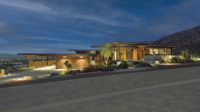In Palm Springs, California, it’s 1956 again: Real estate developer Maxx Livingstone is replicating the decades-old residential designs of William Krisel, AIA. During the 1950s, the architect and his former partner Dan Palmer worked with Alexander Construction to build 2,500 post-and-beam tract houses. That collaboration doubled the city’s size and produced weekend-getaway residences that helped define its accessible, Modernist identity. Robert Parker, director of Prudential Palm Springs’s architectural division, says that a growing number of purchasers are restoring these so-called “Alexander homes” to their original look—and that authentic examples are withstanding downward-facing sales trends. “The real estate market obviously has adjusted throughout the U.S., but there is still a huge marketplace for these buildings,” Parker says of one recent $1.6 million sale.

Photo © David Blank Photo
The project’s financial success comes as no surprise to the co-founders of Vancouver, British Columbia–based Maxx Livingstone. During a month-long family vacation in 2005, brothers Michael and Bob Friedman unwittingly rented—and became smitten by—an Alexander home sporting a Palmer & Krisel butterfly-roof. “It was one of those moments that my brother and I looked at each other and asked, ‘Why aren’t people building these?’” Michael Friedman recalls. An acquaintance mentioned that Krisel, 83, had retired from practice but was still doing work in architectural forensics. “We talked about our philosophies and we ended up signing a deal with him,” Friedman says, adding that Maxx Livingstone licensed Krisel’s designs in a 10-year contract.
In addition to the 1,625-square-foot house with a butterfly roof, of which four speculative and custom-built residences are completed or underway, Maxx Livingstone plans to develop long-gable and flat- and pitched-roof designs as national economic trends improve. Krisel is deeply involved when the company builds the first of any design; he has also created a 425-square-foot casita, to be used as a home office or guest quarters, that can be appended to the garage volume.
The butterfly houses appear largely unchanged from the original 1950s version, with clerestory windows on the front elevation and the trough of the roof marking an interior hallway that separates public from private rooms. Krisel and Maxx Livingstone have updated the design to satisfy California’s current building codes—an exercise that involves adding bracing and changing several construction specs to meet higher wind-load and seismic standards, says Mike Flannery, president of partner construction company Solterra Development. Additional changes acknowledge today’s focus on sustainability. Double-glazed windows, blow-in batting, new ventilation systems, and generous roof insulation achieve greater efficiency in the tough desert climate; the optional addition of low-flow water fixtures, solar thermal heating, site recycling, and drought-resistant landscaping can qualify houses for LEED certification.
In true mid-century spirit, Friedman says he and his brother are considering developing a subdivision in Palm Springs that would include as many as 24 Krisel houses. Maxx Livingstone is also launching a prefabricated version of the butterfly design in late May.






Post a comment to this article
Report Abusive Comment